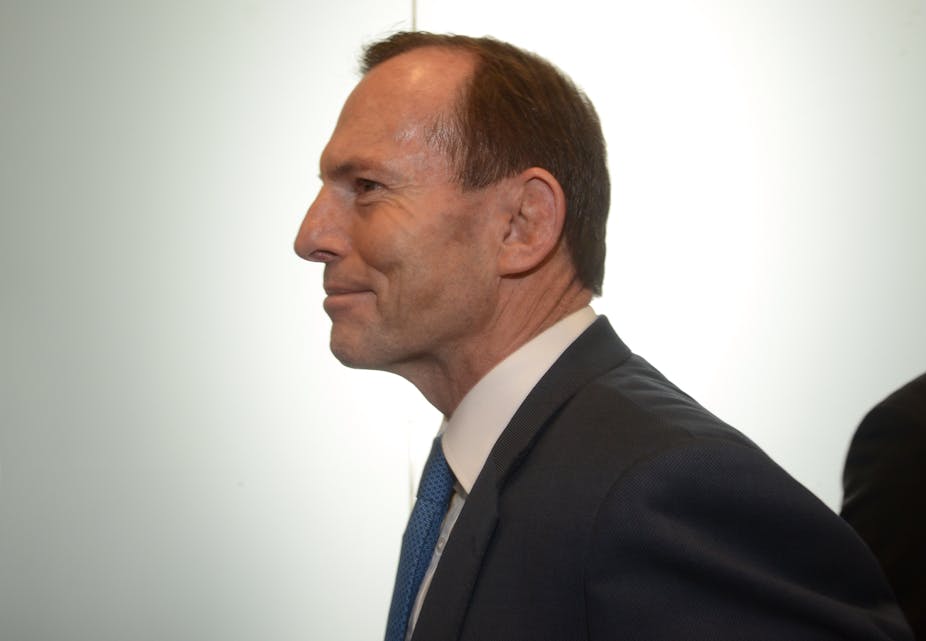Perhaps the Abbott government can solve its climate change problem by revisiting an old Coalition policy.
Before the 2013 election the Coalition promised to cut the “carbon tax”, introduce direct action on climate change, and bring the budget back into surplus sooner than the Labor party.
Although the term “carbon tax” has become widely used, it is misleading. The current Clean Energy Future policy is actually an emissions trading scheme (ETS) with a temporary fixed price that funds the uptake of cleaner energy.
Since the 2013 election two major problems have become highly pertinent.
First, the promises are contradictory. Cutting the “carbon tax” reduces income. Paying for direct action is expensive. This makes balancing the budget more difficult.
A recent study commissioned by the Climate Institute in 2013, found that an extra $4 billion to $15 billion would be required in addition to the funds committed by the government to reach our 2020 emission reduction targets.
Direct action is not going to be efficient in terms of the cost per tonne of carbon dioxide reduced. And it is unlikely to be effective in achieving even the modest target of a 5% reduction in emissions by 2020 without a large increase in funding.
The second problem for the government is that both the Labor party and the Greens are willing to block these policies in the senate. The Greens plan to block any cuts to the current Clean Energy Future policy, while Labor will only support cutting the carbon tax if it is replaced by another ETS.
The solution comes from the Coalition itself through one of the former Howard government’s policies. This may surprise many readers, since Howard has been consistently sceptical about the seriousness of climate change impacts, and while he proposed this policy, he never implemented it.
In 2007 the Howard government’s Prime Ministerial Task Group on Emissions Trading recommended an ETS. This was a simpler and cheaper forerunner to the current Clean Energy Future policy.
Under this policy, the government would still set an annual cap on emissions that could be lowered steadily to meet future emission reduction targets, but there is no fixed price period.
The price of permits for business under the Howard ETS should be lower, as two-thirds would be given away for free initially. The proportion of free permits would be slowly reduced to one-third over decades.
There is also no funding for clean energy, making it cheaper for the government.
Direct action could still be undertaken to offset emissions, but it would be funded by the polluter not the taxpayer. Businesses could choose the cheapest option: reducing emissions, buying permits, or paying for offsets.
Further, the Howard ETS could still allow for the trade in international permits, such as the European Union scheme or the Kyoto Protocol’s Clean Development Mechanism. This would push down the price of permits further and give business even more choice.
In short, adopting the Howard ETS would allow for the abolition of the “carbon tax” and support opportunities for direct action. It would also avoid a multi-billion dollar cost for taxpayers and generate revenue through the sale of one-third of the permits, which would help bring the budget back into surplus more quickly.
Politically, it would meet the demands of the Labor party and avoid the risk of having changes to climate policy blocked in the senate.
But what about business? Doesn’t it oppose an ETS? Won’t it be bad for the economy? Surprisingly, the answer is no.
Responses by 180 firms across a broad cross-section of industries to an AECOM survey in 2013 found that 88% supported reducing greenhouse gas emissions: 65% supported an ETS as their preferred model, but only 7% supported the direct action model.
This supports some of our earlier research which found that using market mechanisms was crucial in overcoming the obstacles to cleaning up the Australian economy. It also supported the “win-win” scenario where well designed polices can be good for both business and the environment.
Climate change poses an ideological problem for the Coalition as it challenges three of their core beliefs:
- that the market is good;
- that government intervention is bad; and
- that environmentalists are wrong.
Climate change demonstrates that the market can produce severe negative side effects for the whole planet - which is bad. Government intervention can correct this side effect - which is good. And environmentalists who have warned that we are doing too much damage to the climate can now call on a large body of scientific research for support - so they are right.
This may be why some senior members of the Coalition refuse to accept the science and even see the issue as some sort of left-wing conspiracy.
How to overcome such views is a real challenge. Perhaps publicising more examples of businesses that have been able to reduce emissions and prosper could help.
If this barrier could be breached, adopting the Howard version of an ETS would allow the government to keep its election promises. And it would be better than direct action for business, taxpayers, the government, and the environment.

